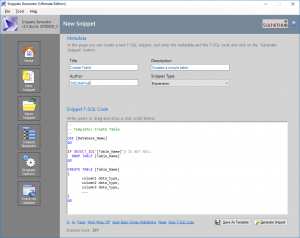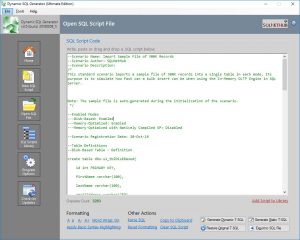Sometimes, under certain circumstances, when you develop in SQL Server and especially when you try to convert a string data type value to a float data type value, you might get the error message: error converting data type varchar to float. As the error message describes, there is a conversion error and this is most probably due to the input parameter value you used in the conversion function.
Read more below on how you can easily resolve this problem.
Reproducing the Data Type Conversion Error
As mentioned above, the actual reason you get this error message, is that you are passing as a parameter to the CAST or CONVERT SQL Server functions, a value (varchar expression) that is invalid and cannot be converted to the desired data type.
Consider the following example:
----------------------------------------- --Variable declaration and initialization ----------------------------------------- DECLARE @value AS VARCHAR(50); SET @value = '12.340.111,91'; --Perform the casting SELECT CAST(@value AS FLOAT); --or --Perform the conversion SELECT CONVERT(FLOAT, @value); -----------------------------------------
If you execute the above code you will get an error message in the following type:
Msg 8114, Level 16, State 5, Line 6
Error converting data type varchar to float.
Another similar example where you get the same data type conversion error, is the below:
----------------------------------------- --Variable declaration and initialization ----------------------------------------- DECLARE @value2 AS VARCHAR(50); SET @value2 = '12,340.15'; --Perform the casting SELECT CAST(@value2 AS FLOAT); --or --Perform the conversion SELECT CONVERT(FLOAT, @value2);
Why you get this Conversion Error
The exact reason for getting the error message in this case is that you are using the comma (,) as a decimal point and also the dots as group digit symbols. Though SQL Server considers as a decimal point the dot (.). Also when converting a varchar to float you must not use any digit grouping symbols.
Strengthen your SQL Server Administration Skills – Enroll to our Online Course!
Check our online course on Udemy titled “Essential SQL Server Administration Tips”
(special limited-time discount included in link).Via the course, you will learn essential hands-on SQL Server Administration tips on SQL Server maintenance, security, performance, integration, error handling and more. Many live demonstrations and downloadable resources included!
(Lifetime Access/ Live Demos / Downloadable Resources and more!) Enroll from $14.99
How to Resolve the Conversion Issue
In order for the above code to execute, you would need to first remove the dots (that is the digit grouping symbols in this case) and then replace the comma with a dot thus properly defining the decimal symbol for the varchar expression.
Note: You need to be careful at this point, in order to correctly specify the decimal symbol at the correct position of the number.
Therefore, you can modify the code of example 1 as per below example:
------------------------------------------- --Variable declaration and initialization ------------------------------------------- DECLARE @value AS VARCHAR(50); SET @value = '12.340.111,91'; --Prepare the string for casting/conversion to float SET @value = REPLACE(@value, '.', ''); SET @value = REPLACE(@value, ',', '.'); --Perform the casting SELECT CAST(@value AS FLOAT); --or --Perform the conversion SELECT CONVERT(FLOAT, @value); -----------------------------------------
If you execute the above code you will be able to get the string successfully converted to float.
Similarly, you can modify the code of example 2 as per below example:
----------------------------------------- --Variable declaration and initialization ----------------------------------------- DECLARE @value2 AS VARCHAR(50); SET @value2 = '12,340.15'; --Prepare the string for casting/conversion to float SET @value2 = REPLACE(@value2, ',', ''); --Perform the casting SELECT CAST(@value2 AS FLOAT); --or --Perform the conversion SELECT CONVERT(FLOAT, @value2);
Again, if you execute the above code you will be able to get the string successfully converted to float.
*Note: Even though you can try changing the regional settings of the PC for setting the dot (.) as the decimal symbol, this will only affect the way the data is presented to you when returned from the casting/conversion call. Therefore, you still have to modify the varchar expression prior to the casting/conversion operation.
Regarding the message: error converting data type varchar to numeric
The above error message is similar to the one we examined in this article, therefore, the way for resolving the issue is similar to the one we described in the article. The only different for the numeric case, is that you will have to replace FLOAT with numeric[ (p[ ,s] )]. Learn more about the numeric data type in SQL Server and how to resolve the above conversion issue, by reading the relevant article on SQLNetHub.
Watch the Live Demonstration on the VARCHAR to FLOAT Data Type Conversion Error
Learn essential SQL Server development tips! Enroll to our Online Course!
Check our online course titled “Essential SQL Server Development Tips for SQL Developers”
(special limited-time discount included in link).Sharpen your SQL Server database programming skills via a large set of tips on T-SQL and database development techniques. The course, among other, features over than 30 live demonstrations!
(Lifetime Access, Certificate of Completion, downloadable resources and more!) Enroll from $14.99
Featured Online Courses:
- SQL Server 2022: What’s New – New and Enhanced Features
- Introduction to Azure Database for MySQL
- Working with Python on Windows and SQL Server Databases
- Boost SQL Server Database Performance with In-Memory OLTP
- Introduction to Azure SQL Database for Beginners
- Essential SQL Server Administration Tips
- SQL Server Fundamentals – SQL Database for Beginners
- Essential SQL Server Development Tips for SQL Developers
- Introduction to Computer Programming for Beginners
- .NET Programming for Beginners – Windows Forms with C#
- SQL Server 2019: What’s New – New and Enhanced Features
- Entity Framework: Getting Started – Complete Beginners Guide
- A Guide on How to Start and Monetize a Successful Blog
- Data Management for Beginners – Main Principles
Read Also:
- The Database Engine system data directory in the registry is not valid
- Useful Python Programming Tips
- SQL Server 2022: What’s New – New and Enhanced Features (Course Preview)
- How to Connect to SQL Server Databases from a Python Program
- Working with Python on Windows and SQL Server Databases (Course Preview)
- The multi-part identifier … could not be bound
- Where are temporary tables stored in SQL Server?
- How to Patch a SQL Server Failover Cluster
- Operating System Error 170 (Requested Resource is in use)
- Installing SQL Server 2016 on Windows Server 2012 R2: Rule KB2919355 failed
- The operation failed because either the specified cluster node is not the owner of the group, or the node is not a possible owner of the group
- A connection was successfully established with the server, but then an error occurred during the login process.
- SQL Server 2008 R2 Service Pack Installation Fails – Element not found. (Exception from HRESULT: 0x80070490)
- There is insufficient system memory in resource pool ‘internal’ to run this query.
- Argument data type ntext is invalid for argument …
- Fix: VS Shell Installation has Failed with Exit Code 1638
- Essential SQL Server Development Tips for SQL Developers
- Introduction to Azure Database for MySQL (Course Preview)
- [Resolved] Operand type clash: int is incompatible with uniqueidentifier
- The OLE DB provider “Microsoft.ACE.OLEDB.12.0” has not been registered – How to Resolve it
- SQL Server replication requires the actual server name to make a connection to the server – How to Resolve it
- Issue Adding Node to a SQL Server Failover Cluster – Greyed Out Service Account – How to Resolve
- Data Management for Beginners – Main Principles (Course Preview)
- Resolve SQL Server CTE Error – Incorrect syntax near ‘)’.
- SQL Server is Terminating Because of Fatal Exception 80000003 – How to Troubleshoot
- An existing History Table cannot be specified with LEDGER=ON – How to Resolve
- … more SQL Server troubleshooting articles
Recommended Software Tools
Snippets Generator: Create and modify T-SQL snippets for use in SQL Management Studio, fast, easy and efficiently.
Learn more
Dynamic SQL Generator: Convert static T-SQL code to dynamic and vice versa, easily and fast.
Learn more
Get Started with Programming Fast and Easy – Enroll to the Online Course!
Check our online course “Introduction to Computer Programming for Beginners”
(special limited-time discount included in link).
(Lifetime Access, Q&A, Certificate of Completion, downloadable resources and more!) Learn the philosophy and main principles of Computer Programming and get introduced to C, C++, C#, Python, Java and SQL.
Enroll from $14.99
Subscribe to our newsletter and stay up to date!
Subscribe to our YouTube channel (SQLNetHub TV)
Easily generate snippets with Snippets Generator!
Secure your databases using DBA Security Advisor!
Generate dynamic T-SQL scripts with Dynamic SQL Generator!
Check our latest software releases!
Check our eBooks!
Rate this article: 
Loading…
Reference: SQLNetHub.com (https://www.sqlnethub.com)
How to resolve the error: Error converting data type varchar to float
Click to Tweet
Artemakis Artemiou is a Senior SQL Server Architect, Author, a 9 Times Microsoft Data Platform MVP (2009-2018). He has over 20 years of experience in the IT industry in various roles. Artemakis is the founder of SQLNetHub and {essentialDevTips.com}. Artemakis is the creator of the well-known software tools Snippets Generator and DBA Security Advisor. Also, he is the author of many eBooks on SQL Server. Artemakis currently serves as the President of the Cyprus .NET User Group (CDNUG) and the International .NET Association Country Leader for Cyprus (INETA). Moreover, Artemakis teaches on Udemy, you can check his courses here.
Views: 25,985
- Remove From My Forums
-
Question
-
I have this query:
SELECT
A.[ID EMPLEADO],A.EMPLEADO,
LTRIM(A.EMPRESA) AS EMPRESA,
CASE A.EMPRESA
WHEN ‘OHSC’ THEN ‘OHSC’
ELSE ‘OH’
END AS OH,
A.[CLAVE PUESTO PS],A.[PUESTO PS],
CONVERT(DECIMAL,A.[CLAVE CLIENTE]) AS [CLAVE CLIENTE],AN.CLIENTE,A.[CLAVE CC],A.CC,
A.FECHA_INGRESO,MONTH(A.FECHA_INGRESO) AS MES,YEAR(A.FECHA_INGRESO) AS AÑO,
AN.SUCURSAL,AN.[GERENCIA REGIONAL],
ISNULL(AN.CORPORATIVO,A.CLIENTE) AS CORPORATIVO,
AN.[PARQUE INDUSTRIAL],AN.GIRO,
GENERO,dbo.fn_RangoEdad(FECHA_NACIMIENTO) AS [RANGO EDAD]
FROM ALTAS A
LEFT JOIN AgrupadoresNomina AN ON A.[CLAVE CLIENTE]=AN.[CLAVE CLIENTE]
EXCEPT
SELECT * FROM vBajas_Cancelacion_PSThat query was working fine, but recently has started to give me the following message:
Msg 8114, Level 16, State 5, Line 1
Error converting data type varchar to float.I’ve tried running the first SELECT, and everything is OK, running the second SELECT and everything is OK.
Also i’ve tried changing the EXCEPT sentence for NOT IN or EXIST (in this case it only shows me 34086 records, then gives me same error), removing the CONVERT from the query, but the result is the same, it gives me the «Error converting data type varchar
to float» message.Can someone help me to get more ideas to find the record or why is now showing me this message?
Thanks in advance!
Answers
-
You are seeing that message because in one of those selects there is a float column and the corresponding column in the other select is a varchar. So when yoou run one select, you get a float result so there is no problem. When you run the other
select, you get a varchar result, so that is also no problem. But when you run them together with the EXCEPT, SQL must convert them to the same type in order to do the compare. Since float has a higher priority than varchar, SQL tries to convert
the value in the varchar column to a float. So for at least one row, you have a value in that varchar column which cannot be converted.If you are on SQL 2012 or later, the best way to find the row(s) causing this error is to run (in the code below, replace <column name> with the name of the varchar column.
Select <column name> From ... Where Try_Convert(float, <column name>) Is Null And <column name> Is Not Null;
If you are on SQL 2008R2 or earlier, you cannot use Try_Convert, but you can do
Select <column name> From ... Where IsNumeric(<column name>) = 0;
That’s not quite as helpful as Try_Convert. If will probably find the row(s) but it might not depending exactly what is in the varchar column.
In addition to selecting the column name, you might also want to select any additional data needed to find the row with the bad data (such as the primary key columns).
Tom
-
Marked as answer by
Wednesday, February 20, 2013 3:48 AM
-
Marked as answer by
-
Does the column datatypes from both SELECT statements are compatible ?
As a test, try inserting the first SELECT statement results into a temp table and then check the data types of all those columns whether compatible with t all column data types of the table/view —
vBajas_Cancelacion_PS (second SELECT statement)SELECT A.[ID EMPLEADO],A.EMPLEADO, LTRIM(A.EMPRESA) AS EMPRESA, CASE A.EMPRESA WHEN 'OHSC' THEN 'OHSC' ELSE 'OH' END AS OH, A.[CLAVE PUESTO PS],A.[PUESTO PS], CONVERT(DECIMAL,A.[CLAVE CLIENTE]) AS [CLAVE CLIENTE],AN.CLIENTE,A.[CLAVE CC],A.CC, A.FECHA_INGRESO,MONTH(A.FECHA_INGRESO) AS MES,YEAR(A.FECHA_INGRESO) AS AÑO, AN.SUCURSAL,AN.[GERENCIA REGIONAL], ISNULL(AN.CORPORATIVO,A.CLIENTE) AS CORPORATIVO, AN.[PARQUE INDUSTRIAL],AN.GIRO, GENERO,dbo.fn_RangoEdad(FECHA_NACIMIENTO) AS [RANGO EDAD] INTO FirstSelectResults -- Added this FROM ALTAS A LEFT JOIN AgrupadoresNomina AN ON A.[CLAVE CLIENTE]=AN.[CLAVE CLIENTE]SP_HELP FirstSelectResults
Narsimha
-
Marked as answer by
AlejandroVR
Wednesday, February 20, 2013 3:49 AM
-
Marked as answer by
I have created a stored procedure which will parse a raw data. The code below is the part of the stored procedure. I’m testing it and it returns an error ‘Error converting data type varchar to float.’. If you will notice I change the raw data in KM2 both in case and in else.
Can someone help me how to make it right, Thanks in advance for all the help guys.
SELECT [Account] = LEFT('351856040520298,241111;1G,141007034741,A,1430.4280N,12100.0551E,0.0,330,0.8,20000000;2G,141007034741,11,22.8,12.87,04.09,273342044.3',CHARINDEX(',','351856040520298,241111;1G,141007034741,A,1430.4280N,12100.0551E,0.0,330,0.8,20000000;2G,141007034741,11,22.8,12.87,04.09,273342044.3') - 1),
[TrxDateTime] = cast(stuff(stuff(stuff((SUBSTRING('351856040520298,241111;1G,141007034741,A,1430.4280N,12100.0551E,0.0,330,0.8,20000000;2G,141007034741,11,22.8,12.87,04.09,273342044.3', 27, 12)), 7,0,' '), 10,0,':'), 13,0,':') as datetime),
[PhilTime] = GETDATE(),
[GPSStatus] = CASE WHEN(SUBSTRING('351856040520298,241111;1G,141007034741,A,1430.4280N,12100.0551E,0.0,330,0.8,20000000;2G,141007034741,11,22.8,12.87,04.09,273342044.3', 40, 1) = 'A')
THEN 'OK'
ELSE 'Message Not Valid' END,
[Lat] = cast(SUBSTRING('351856040520298,241111;1G,141007034741,A,1430.4280N,12100.0551E,0.0,330,0.8,20000000;2G,141007034741,11,22.8,12.87,04.09,273342044.3', 42, 9) as float)/100,
[Long] = cast(SUBSTRING('351856040520298,241111;1G,141007034741,A,1430.4280N,12100.0551E,0.0,330,0.8,20000000;2G,141007034741,11,22.8,12.87,04.09,273342044.3', 53, 10) as float)/100,
[Speed2] = cast(SUBSTRING('351856040520298,241111;1G,141007034741,A,1430.4280N,12100.0551E,0.0,330,0.8,20000000;2G,141007034741,11,22.8,12.87,04.09,273342044.3', 65, 1) as float)*1.852/1000,
[ENGINE] = CASE WHEN (SUBSTRING('351856040520298,241111;1G,141007034741,A,1430.4280N,12100.0551E,0.0,330,0.8,20000000;2G,141007034741,11,22.8,12.87,04.09,273342044.3', 77, 1) = '2')
THEN 'ON'
ELSE 'OFF' END,
[KM2] = CASE WHEN(right('351856040520389,241111;1G,141209203228,A,1437.3980N,12103.6893E,0.0,44,0.8,01004000', 11) like '%,%')
THEN 'NULL'
--ELSE 'BDADADADAD' END,
ELSE round(cast(right('351856040520389,241111;1G,141209203228,A,1437.3980N,12103.6893E,0.0,44,0.8,01004000', 11)as float)/3600, 0, 1) END,
[PlateNo] = NULL,
[ProcStatus] = '0';
Error I kept on running into is
Msg 8114, Level 16, State 5, Line 1
Error converting data type varchar to float.
I have created a stored procedure which will parse a raw data. The code below is the part of the stored procedure. I’m testing it and it returns an error ‘Error converting data type varchar to float.’. If you will notice I change the raw data in KM2 both in case and in else.
Can someone help me how to make it right, Thanks in advance for all the help guys.
SELECT [Account] = LEFT('351856040520298,241111;1G,141007034741,A,1430.4280N,12100.0551E,0.0,330,0.8,20000000;2G,141007034741,11,22.8,12.87,04.09,273342044.3',CHARINDEX(',','351856040520298,241111;1G,141007034741,A,1430.4280N,12100.0551E,0.0,330,0.8,20000000;2G,141007034741,11,22.8,12.87,04.09,273342044.3') - 1),
[TrxDateTime] = cast(stuff(stuff(stuff((SUBSTRING('351856040520298,241111;1G,141007034741,A,1430.4280N,12100.0551E,0.0,330,0.8,20000000;2G,141007034741,11,22.8,12.87,04.09,273342044.3', 27, 12)), 7,0,' '), 10,0,':'), 13,0,':') as datetime),
[PhilTime] = GETDATE(),
[GPSStatus] = CASE WHEN(SUBSTRING('351856040520298,241111;1G,141007034741,A,1430.4280N,12100.0551E,0.0,330,0.8,20000000;2G,141007034741,11,22.8,12.87,04.09,273342044.3', 40, 1) = 'A')
THEN 'OK'
ELSE 'Message Not Valid' END,
[Lat] = cast(SUBSTRING('351856040520298,241111;1G,141007034741,A,1430.4280N,12100.0551E,0.0,330,0.8,20000000;2G,141007034741,11,22.8,12.87,04.09,273342044.3', 42, 9) as float)/100,
[Long] = cast(SUBSTRING('351856040520298,241111;1G,141007034741,A,1430.4280N,12100.0551E,0.0,330,0.8,20000000;2G,141007034741,11,22.8,12.87,04.09,273342044.3', 53, 10) as float)/100,
[Speed2] = cast(SUBSTRING('351856040520298,241111;1G,141007034741,A,1430.4280N,12100.0551E,0.0,330,0.8,20000000;2G,141007034741,11,22.8,12.87,04.09,273342044.3', 65, 1) as float)*1.852/1000,
[ENGINE] = CASE WHEN (SUBSTRING('351856040520298,241111;1G,141007034741,A,1430.4280N,12100.0551E,0.0,330,0.8,20000000;2G,141007034741,11,22.8,12.87,04.09,273342044.3', 77, 1) = '2')
THEN 'ON'
ELSE 'OFF' END,
[KM2] = CASE WHEN(right('351856040520389,241111;1G,141209203228,A,1437.3980N,12103.6893E,0.0,44,0.8,01004000', 11) like '%,%')
THEN 'NULL'
--ELSE 'BDADADADAD' END,
ELSE round(cast(right('351856040520389,241111;1G,141209203228,A,1437.3980N,12103.6893E,0.0,44,0.8,01004000', 11)as float)/3600, 0, 1) END,
[PlateNo] = NULL,
[ProcStatus] = '0';
Error I kept on running into is
Msg 8114, Level 16, State 5, Line 1
Error converting data type varchar to float.
Вопрос:
Поиск и поиск по SO и не может понять это
Пробовал CASTING в каждом поле как FLOAT безрезультатно, конвертер не получил меня дальше
Как я могу получить предложение ниже case, чтобы вернуть значение, указанное в разделе THEN?
Ошибка:
Msg 8114, уровень 16, состояние 5, строка 1
Ошибка преобразования типа данных varchar в float.
моего SQL-запроса, который делает ошибку:
When cust_trendd_w_costsv.terms_code like '%[%]%' and (prod.dbo.BTYS2012.average_days_pay) - (substring(cust_trendd_w_costsv.terms_code,3,2)) <= 5 THEN prod.dbo.cust_trendd_w_costsv.terms_code
average_days_pay = float
terms_code = char
Ура!
Лучший ответ:
Попробуйте использовать ISNUMERIC для обработки строк, которые нельзя преобразовать:
When cust_trendd_w_costsv.terms_code like '%[%]%'
and (prod.dbo.BTYS2012.average_days_pay) -
(case when isnumeric(substring(cust_trendd_w_costsv.terms_code,3,2))=1
then cast(substring(cust_trendd_w_costsv.terms_code,3,2) as float)
else 0
end)
<= 5 THEN prod.dbo.cust_trendd_w_costsv.terms_code
Ответ №1
Проблема, с которой вы сталкиваетесь, заключается в том, что вы специально ищете строки, содержащие символ %, а затем преобразовывая их (неявно или явно) в float.
Но строки, содержащие знаки %, не могут быть преобразованы в float, в то время как у них все еще есть %. Это также приводит к ошибке:
select CONVERT(float,'12.5%')
Если вы хотите конвертировать в float, сначала нужно удалить знак %, например:
CONVERT(float,REPLACE(terms_code,'%',''))
просто устранит его. Я не уверен, есть ли другие символы в столбце terms_code, которые могут также отключить его.
Вам также необходимо знать, что SQL Server может довольно агрессивно переупорядочить операции и поэтому может попытаться выполнить вышеуказанное преобразование в других строках в terms_code, даже те, которые не содержат %. Если это источник вашей ошибки, вам необходимо предотвратить этот агрессивный переупорядочивание. Если нет агрегатов, выражение CASE обычно может избежать наихудших проблем – убедитесь, что все строки, которые вы не хотите обрабатывать, устраняются более ранними предложениями WHEN, прежде чем пытаться преобразовать
Ответ №2
Если вы уверены, что Substring Part возвращает числовое значение, вы можете вставить подстроку (….) в Float:
.....and (prod.dbo.BTYS2012.average_days_pay) - (CAST(substring(cust_trendd_w_costsv.terms_code,3,2)) as float ) <= 5 ....
CASE
WHEN (Cast(CONVERT(DECIMAL(10,2),(totaleffort/7.40)) as nvarchar)- FLOOR(Cast(CONVERT(DECIMAL(10,2),(totaleffort/7.40)) as nvarchar)))> 0 AND (Cast(CONVERT(DECIMAL(10,2),(totaleffort/7.40)) as nvarchar)- FLOOR(Cast(CONVERT(DECIMAL(10,2),(totaleffort/7.40)) as nvarchar)))<=0.25 THEN (0.25+FLOOR(Cast(CONVERT(DECIMAL(10,2),(totaleffort/7.40)) as nvarchar)))
WHEN (Cast(CONVERT(DECIMAL(10,2),(totaleffort/7.40)) as nvarchar)- FLOOR(Cast(CONVERT(DECIMAL(10,2),(totaleffort/7.40)) as nvarchar)))> 0.25 AND (Cast(CONVERT(DECIMAL(10,2),(totaleffort/7.40)) as nvarchar)- FLOOR(Cast(CONVERT(DECIMAL(10,2),(totaleffort/7.40)) as nvarchar)))<=0.50 THEN (0.50+FLOOR(Cast(CONVERT(DECIMAL(10,2),(totaleffort/7.40)) as nvarchar)))
WHEN (Cast(CONVERT(DECIMAL(10,2),(totaleffort/7.40)) as nvarchar)- FLOOR(Cast(CONVERT(DECIMAL(10,2),(totaleffort/7.40)) as nvarchar)))> 0.50 AND (Cast(CONVERT(DECIMAL(10,2),(totaleffort/7.40)) as nvarchar)- FLOOR(Cast(CONVERT(DECIMAL(10,2),(totaleffort/7.40)) as nvarchar)))<=0.75 THEN (0.75+FLOOR(Cast(CONVERT(DECIMAL(10,2),(totaleffort/7.40)) as nvarchar)))
WHEN (Cast(CONVERT(DECIMAL(10,2),(totaleffort/7.40)) as nvarchar)- FLOOR(Cast(CONVERT(DECIMAL(10,2),(totaleffort/7.40)) as nvarchar)))> 0.75 AND (Cast(CONVERT(DECIMAL(10,2),(totaleffort/7.40)) as nvarchar)- FLOOR(Cast(CONVERT(DECIMAL(10,2),(totaleffort/7.40)) as nvarchar)))<1 THEN (1+FLOOR(Cast(CONVERT(DECIMAL(10,2),(totaleffort/7.40)) as nvarchar)))
WHEN (Cast(CONVERT(DECIMAL(10,2),(totaleffort/7.40)) as nvarchar)- FLOOR(Cast(CONVERT(DECIMAL(10,2),(totaleffort/7.40)) as nvarchar)))= 0 THEN (0+FLOOR(Cast(CONVERT(DECIMAL(10,2),(totaleffort/7.40)) as nvarchar)))
END
AS Estimated_Effort_Days,
Приведенный выше код в настоящее время округляет поле с именем totaleffort до ближайшего 25, например, если у меня значение 78.19, оно будет округлено до 78.25.
У меня есть новое требование для значения нуля, когда значение = 0, тогда мне нужно отобразить текст «неизвестный номер». Я попытался добавить дополнительный оператор case, однако запрос не выполняется с ошибкой:
Ошибка преобразования типа данных varchar в float.
Есть ли у кого-нибудь рекомендации для меня?
Last Modified Date: 24 Aug 2022
Issue
When you try to extract a SQL Server data source, one of the following errors might occur:
- An error occurred while communicating with data source <Data Source Name>.
SQL Server database error 0x80040E07: Error converting data type varchar to float. - [Microsoft][SQL Server Native Client 11.0][SQL Server] Error converting data type varchar to float
Unable to create extract
Environment
Tableau Desktop
Microsoft SQL Server
Resolution
Use one of the following options, as appropriate to your data:
- Create a calculated field to strip currency symbols and commas from your data before converting it.
- Ensure that characters such as the plus (+) sign, minus (-) sign and decimal point (.) are positioned in a valid number format. For example, plus and minus signs can only be used to the left of a number (For example, -2).
- If your string data values are currency, you can use rawSQL to cast the string to SQL Server’s MONEY data type before casting to a number. For example:
RAWSQL_REAL("CASE WHEN ISNUMERIC(%1) = 1 THEN CAST(CAST(%1 AS MONEY) AS FLOAT) END", [<Your_String_Field>])
Cause
This error occurs because SQL Server is unable to convert string values to a numeric value if the string contains the following:
- Currency symbol such as $, £, or ¥. For example, «$123».
- Commas. For example, «100,000».
- A single character of: currency symbol, comma(,), decimal point (.), plus (+) sign, or minus (-) sign. For example, «$».
- More than one period. For example, «1.1.0».
- Incorrectly positioned plus (+) or minus (-) signs. For example, «2-«.





